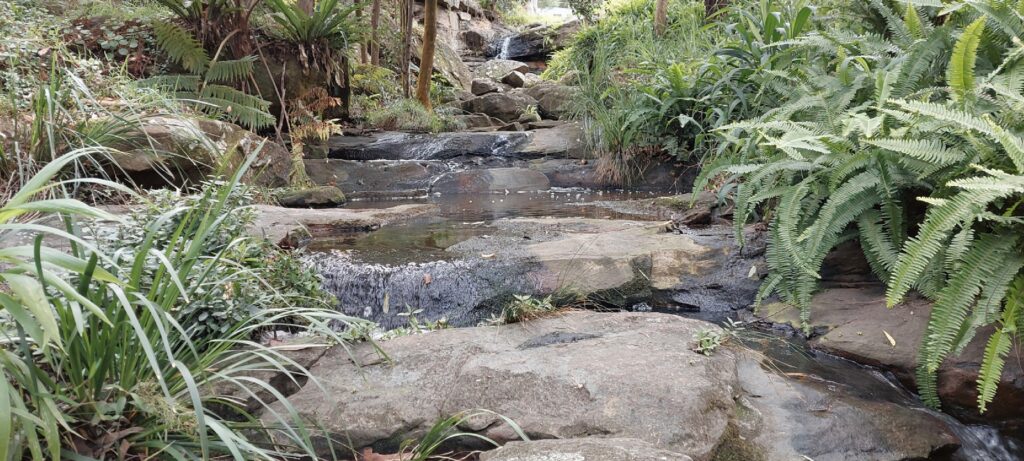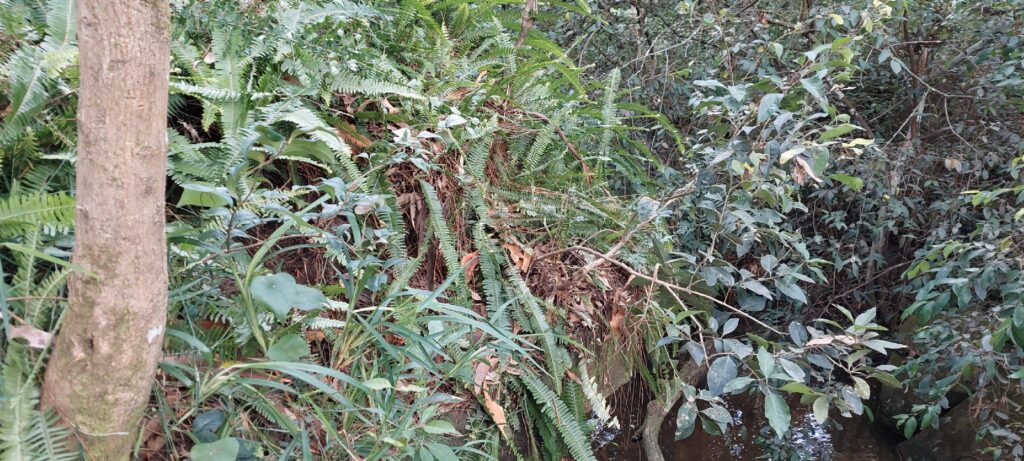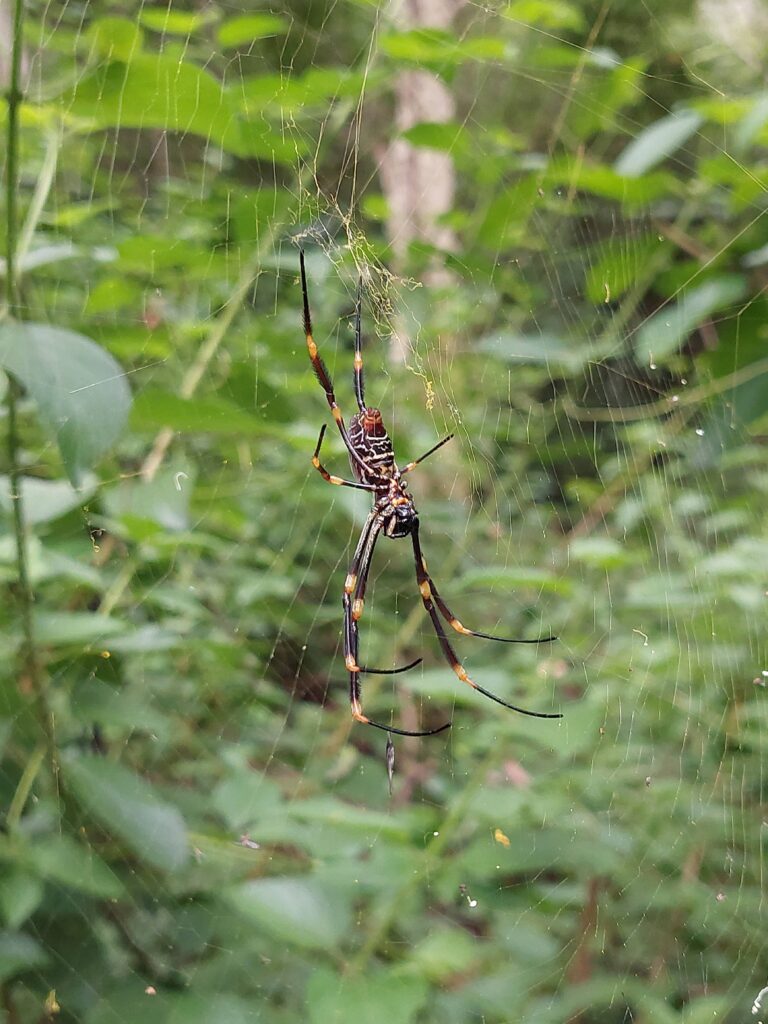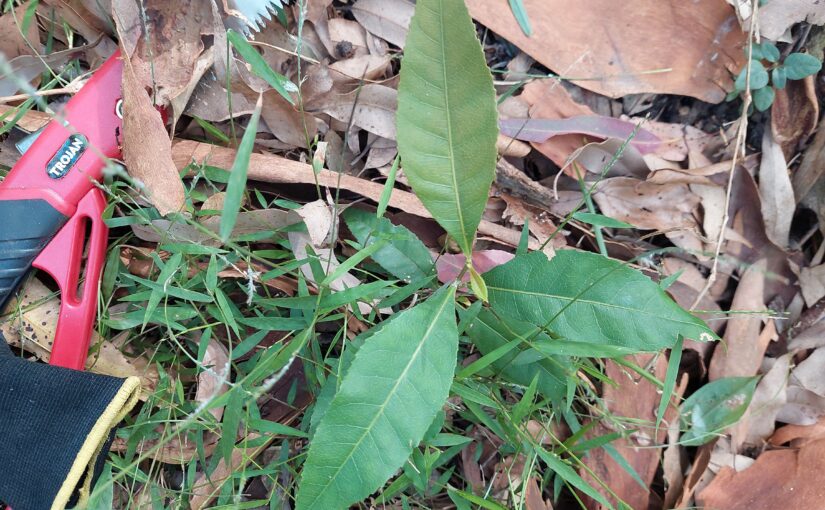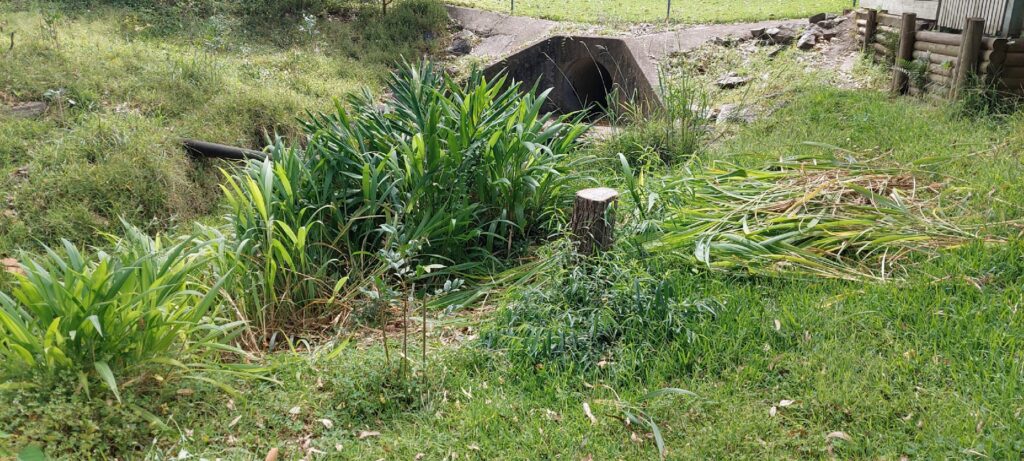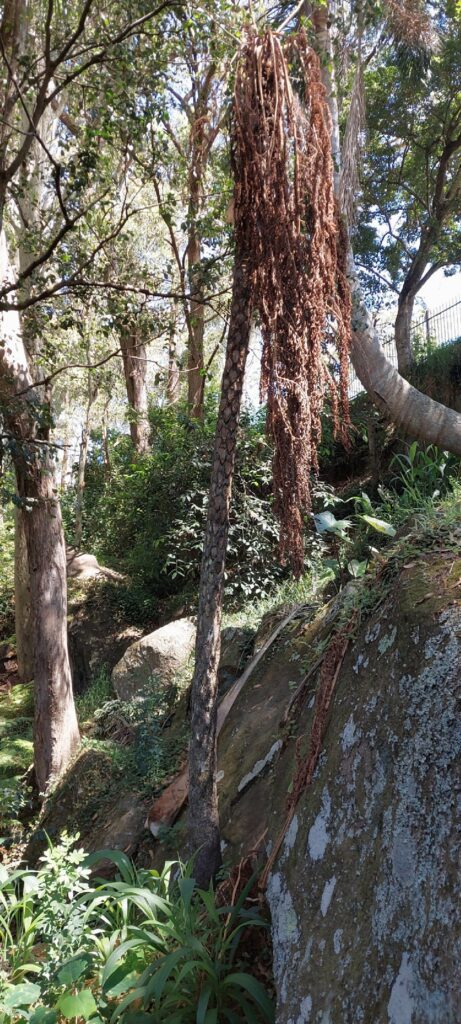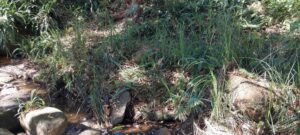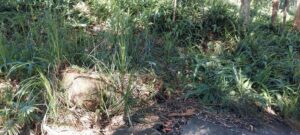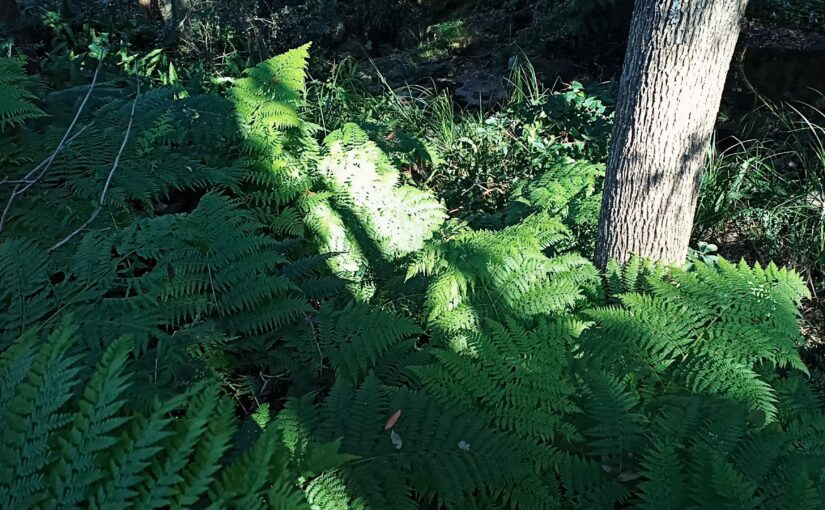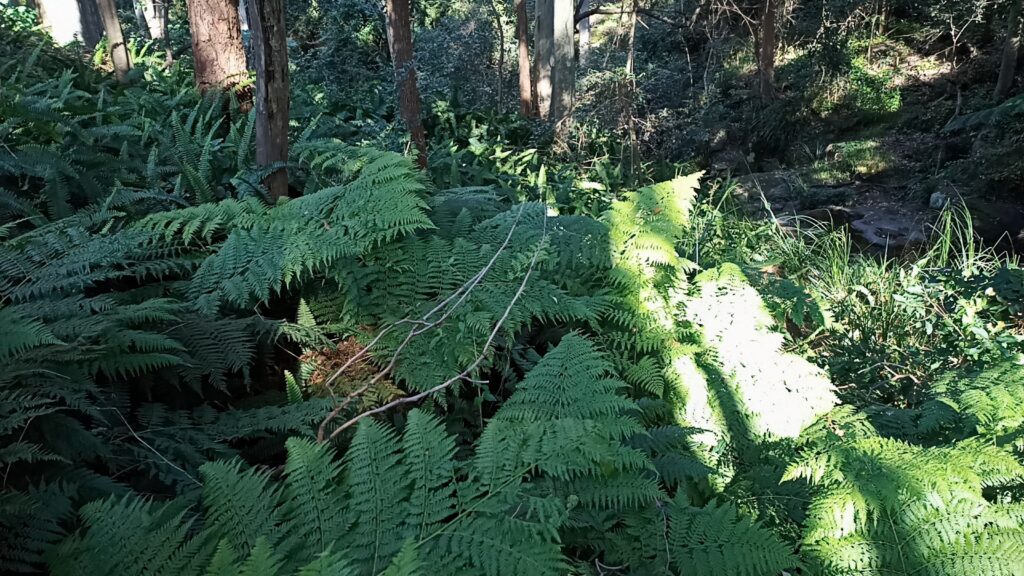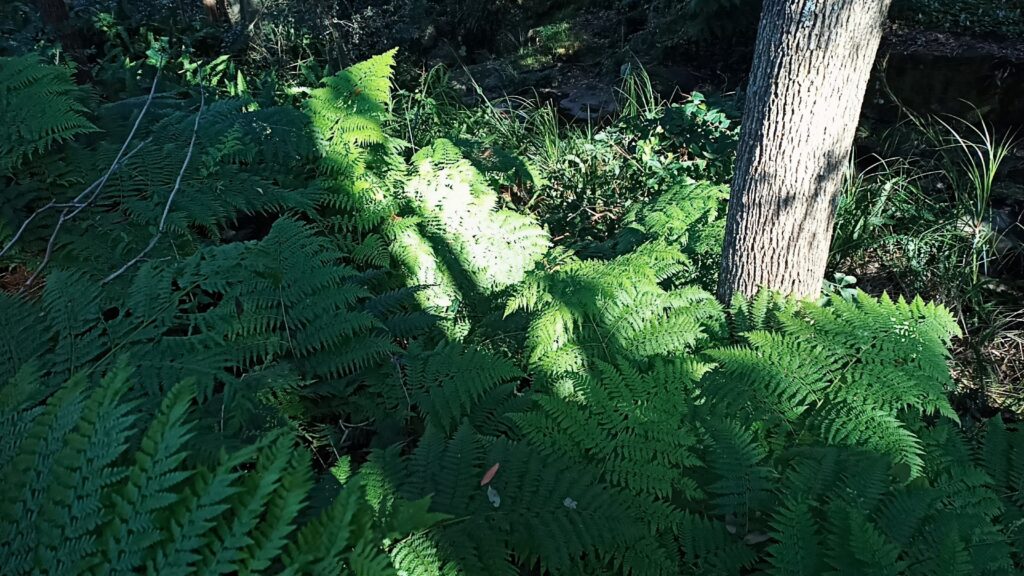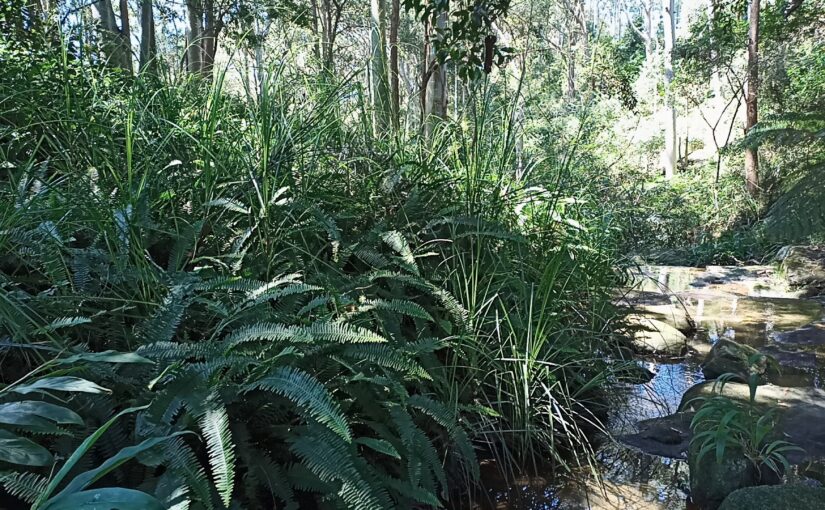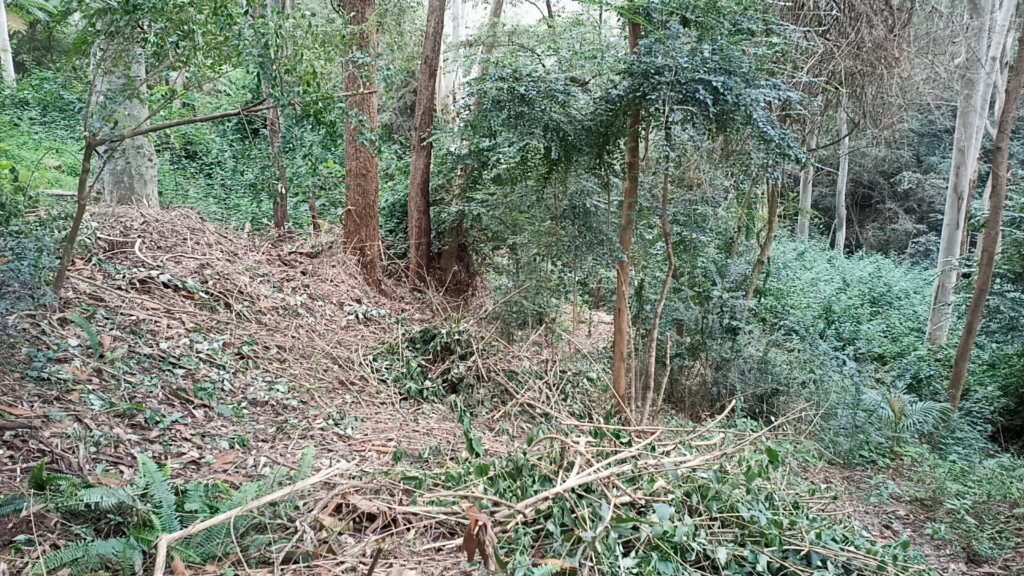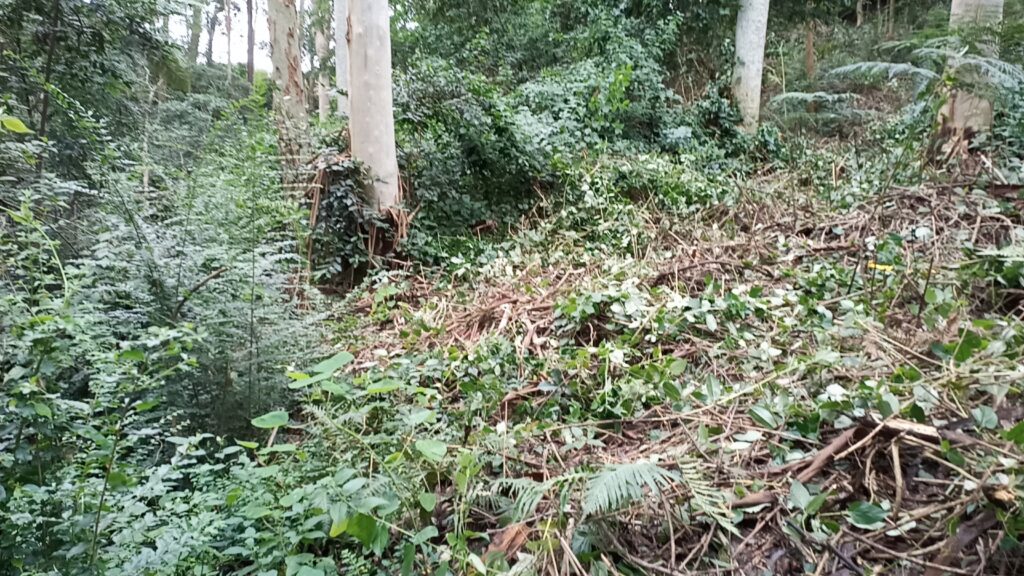Dependent on the weather, this weekend should be good for another Working Bee. If you would like to volunteer some time for Bush Regeneration at Dick’s Creek Landcare, please let me know via the contact page.
Tag: working bee
Working Bee – 06.02.2022
Was able to do a solid 3hrs on the Saturday which felt quite productive. Great day for bush regeneration with a cloudy day keeping it quite cool and previous rains making the soil easy to work with.
We have had a lot of rain so everything is growing well at the moment.
Including the weeds unfortunately. The track from second fall that I normally use had been swallowed by fishbone ferns.
So that was a good place to start… I looked through the fishbone fern for any natives and cleared around those. I found pittosporums, false bracken, blue flax lilly and others who were all doing their best to stay above the fishbone fern. I have done this multiple times now and each time the desired native plants get more numerous and larger. It is all heading in the right direction.
A native olive tree that I had previous cleared around is doing well with new growth showing but no new shoots closer to the cliff were visible. Still, other natives were taking advantage so that’s a win.
Notice the blue flax lilly and elderberry panax in the bottom left corner…
After this I moved down the lower creek section and pushed back lantana around a stand of bracken that I have posted about previously. Unfortunately the rain came in so no photos.
There are many seedlings of desired species popping up at present. Another two years will see a transformation I believe.
One last thing I could not resist taking a photo of was this spider. A beautiful specimen I thought… A golden orb spider I have been informed.
I’m looking forward to next weekend. My intention is to once again look for natives that need some more space to grow but there is also an infestation of Swedish Ivy that needs attention. It has been disturbing to see it popping up in more and more places.
Working Bee – 23.01.2022
Was able to get another 3 or so hours in this afternoon. I took the weedpuller down with me to help with some privet but in the end, I didn’t get to the section I intended to work on (nothing new there…).
Palm grass has been getting ignored for the last six months or so and it was showing. Multiple spots where it was getting far too healthy. So I tried the weedpuller out on the palm grass and surprisingly, it made easy work of it. I expect it depends on how soft the ground is but as it was, it made easy work of most of it (easier than a mattock at least). I dared not clear all of it in case it was holding the bank together but I did enough to keep the shade off the nearby cheese tree sapling.
I was disturbed to find the tree fern near first fall was in dire straights. I hope it makes it. It seems that removing the camphor laurel has just allowed too much light to reach it. Fingers crossed that it adjusts to having more light for a while.
Once again, I decided to help out the Gahnia by picking on the fishbone fern. Not removing all of the fishbone fern but rather, just thinning it out and breaking off any large fronds. It is a slow process but it seems to be working. I hope the area along the creek between first and second falls will end up being mostly Gahnia.
Another inspection at the top of 2nd falls shows the Swedish Ivy really taking off.
On the positive side, the area has a variety of desired species doing well
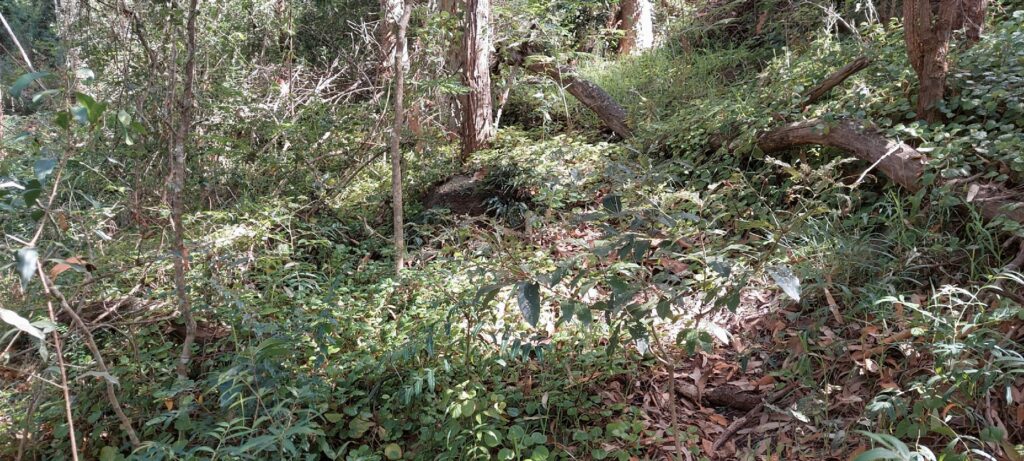
Including a first for Dick’s Creek, a Blueberry Ash.

I do need to address the Swedish Ivy issue but today I only got to the a couple of privet trees and some camphor laurels. A productive day though.
Working Bee – 09.01.2022
Had a chance to get some more done at Dick’s creek for the first time in the new year.
As always, I deviated away from my original target after noting some weeds on the way. On the lower west bank of first fall I noticed a healthy stand of Croften weed & mistflower.

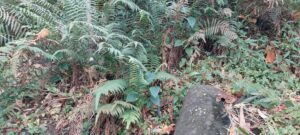 Not surprising of course considering that these invasives dominated the spot a few years ago. It didn’t take long to do some maintenance to get rid of most of it. This area is doing well mostly. Native ferns and trees are growing stronger and the weeds are having a harder and harder time.
Not surprising of course considering that these invasives dominated the spot a few years ago. It didn’t take long to do some maintenance to get rid of most of it. This area is doing well mostly. Native ferns and trees are growing stronger and the weeds are having a harder and harder time.
I videoed progress while I was there…
I took some video at ‘Site A’ and also after manually removing some lantana behind 16 Green Valley Rd. I took some more photos and video of an issue I have with lantana rafts taking too much space. I am convinced that most bush regeneration advice is aimed at large sites where rafts can be built and forgotten. However, as there so much lantana at Dick’s creek and the site is relatively small, I find those piles of dead lantana take up too much space so I have tried a few options to speed up the breakdown. Firstly, I was spreading out the dead branches rather than piling them. Normally this is not done as it is possible the branches will reroot but I take this into consideration and find that spreading out the branches is an improvement.
Another approach I have now had success with, is to pile green leafy weeds in with the raft when it is made. It keeps the moisture in contact with the dead branches and hence hastens the process. Key with both approaches is to reduce the size of the branches as much as possible.
Finally, I got to the back of the reserve, near the creek, where I intended to spend most of the time on. Privet is the main issue at this location. I found multiple native saplings taking off at this location so I ended up just trying to keep the privet away from these guys.
In this shot, the pittosporum can be seen. A lot of the surrounding privet has been pulled out and will soon die.
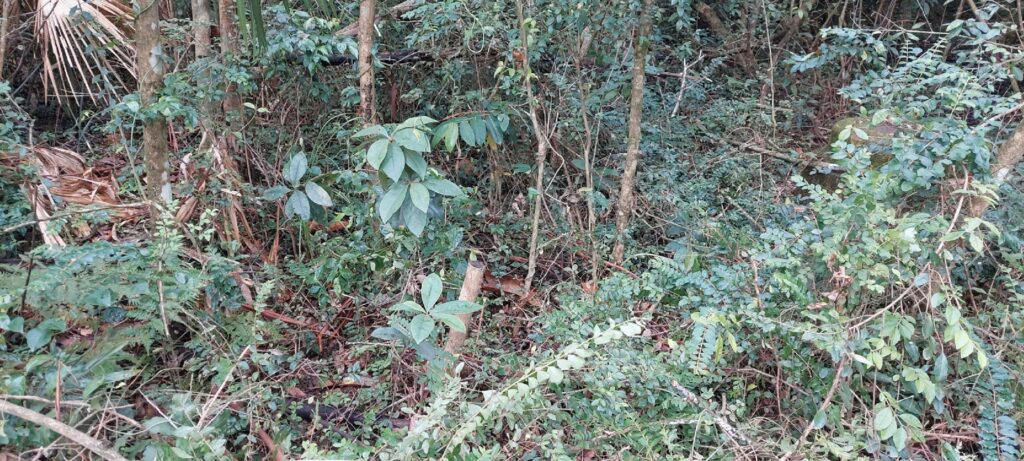
Here we can see a small Cheese tree and another small tree of that as of yet unidentified tree that appears to like the area.
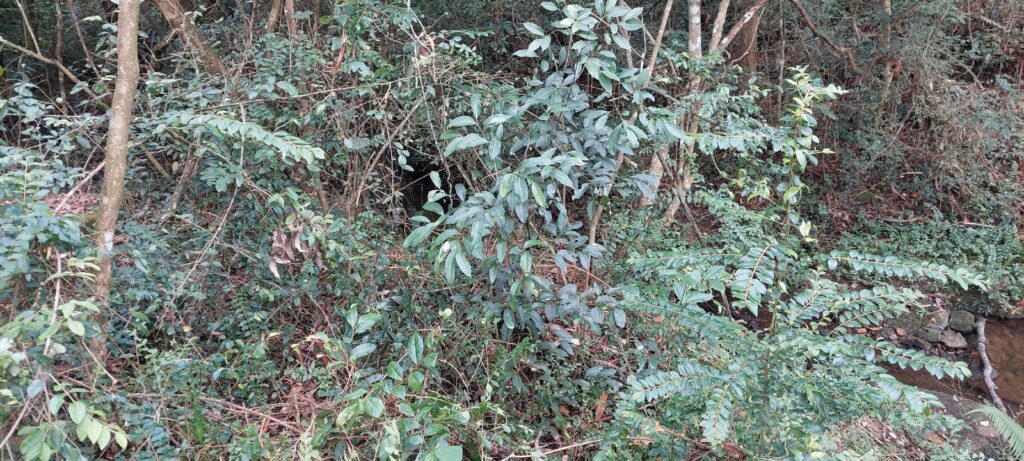 Hopefully I can do more for these in future working bees as they are struggling against the privet.
Hopefully I can do more for these in future working bees as they are struggling against the privet.
Working Bees back
At present, there are still some extra restrictions or procedures that still need to be followed as per the email (shown below) sent via Lake Macquarie landcare:
Dear Landcare volunteer,
Following the recent announcement that the state has achieved 80% COVID-19 vaccination status, Landcare activities can recommence as of this Monday, the 18th of October. In line with Public Health Orders and Council’s COVID Risk Assessment, the following controls will be required to be met for all Landcare work sessions.
At the beginning of each work session Team Leaders will need to undertake a tool box talk to discuss these controls.
Required controls:
• Stay at home if unwell or if you have been to a potential exposure site
• Maintain social distancing of 1.5 metres between people
• Wash and/or sanitise hands regularly
• Avoid sharing of tools and practice regular tool cleaning
• No sharing of drink or foods
• No car-pooling outside of household members
• Double vaccination is a requirement to be able to volunteer or Medical exemption if you are unable to be
vaccinated due to medical reasons
• Signing on to the Daily Work Diary indicates that you would be able to demonstrates your vaccination status (or
medical exemption) to an Authorised Officer if required (e.g. Police officer)
• Mask wearing in outdoor environments is optional
• In the event that you or a volunteer receive a positive COVID-19 test result or notification as a close contact
and have been volunteering since exposure
or the exposure occurred at site, you MUST contact NSW Health and the Landcare Resource Centre at the earliest
opportunity, providing names and contact details of all volunteers working on that date
• If you have volunteers or members of the public challenging your presence or these controls – refer them to the
Landcare Resource Centre 4921 0392 or Council on 4921 0333.
If you anticipate you will need any assistance implementing any of these controls, or if you have any concerns, please contact the Landcare Resource Centre.
Unfortunately, I still have a few weeks before my second jab is administered so working bees will have to wait until then but not long now…
Working Bee – 18.04.2021
It was a late start for Sunday’s working bee but it still turned out to be a productive day.
Mist flower is popping up again in numbers. Grrrr. I am not sure if that one will ever completely disappear. It seems fairly well established in the seedbank. Some of the plants grow in very difficult to access locations so they do not get removed as quickly as I would prefer.
One win I noticed on the weekend is the false bracken fern on the East bank after first fall. I had noticed a few struggling bracken ferns amongst the fishbone fern about twelve months ago. I cleared around those and they expanded and I cleared around that and it has expanded again. It appears the false bracken fern is very capable at taking on the fishbone fern. when it gets a chance.
Another win was a dead camphor laurel tree which the green team had dealt with in their last visit. A bunch of privet was also killed via glyphosate. I typically avoid using herbicides but then, I tend to end up with situations as seen at ‘Glen’s alley’ which has a troubling number of privet saplings and trees springing up.
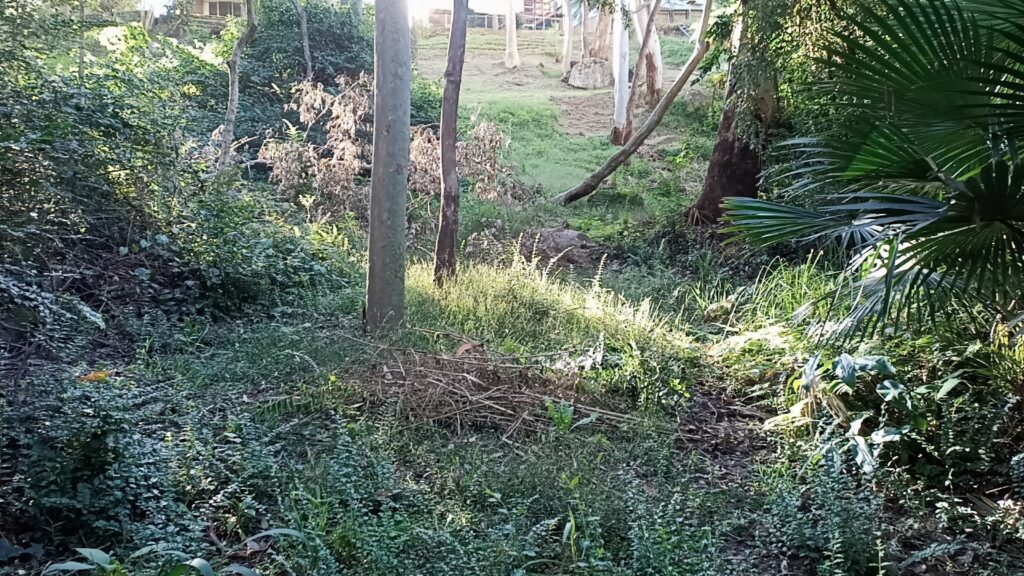

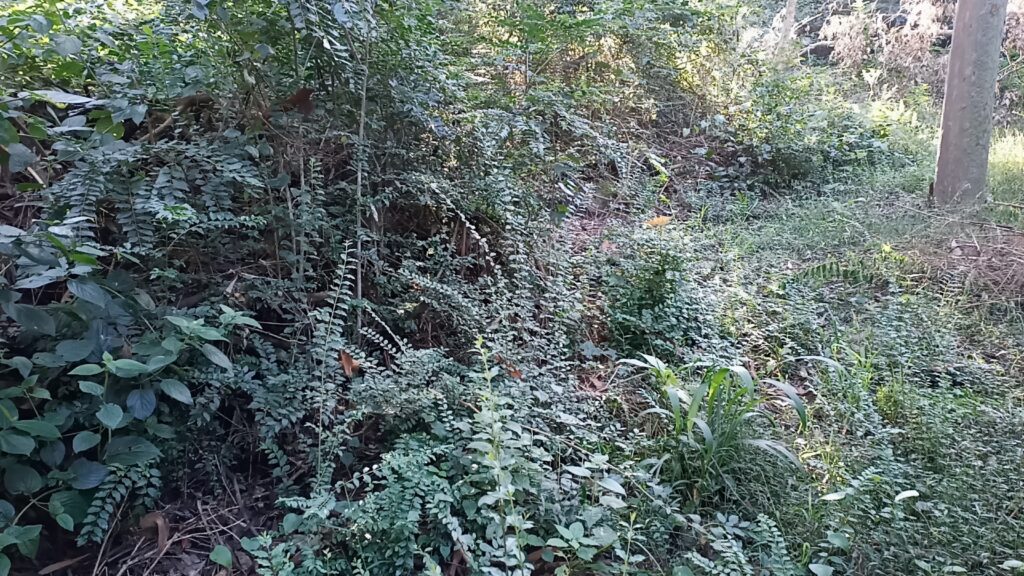
My original intention was to start on the area in the photo above but instead, I learned a large, dead, rotting tree had finally fallen. I had noticed it a long time ago and was amazed it was still standing given the amount of rot at the base. Finally it has come down.
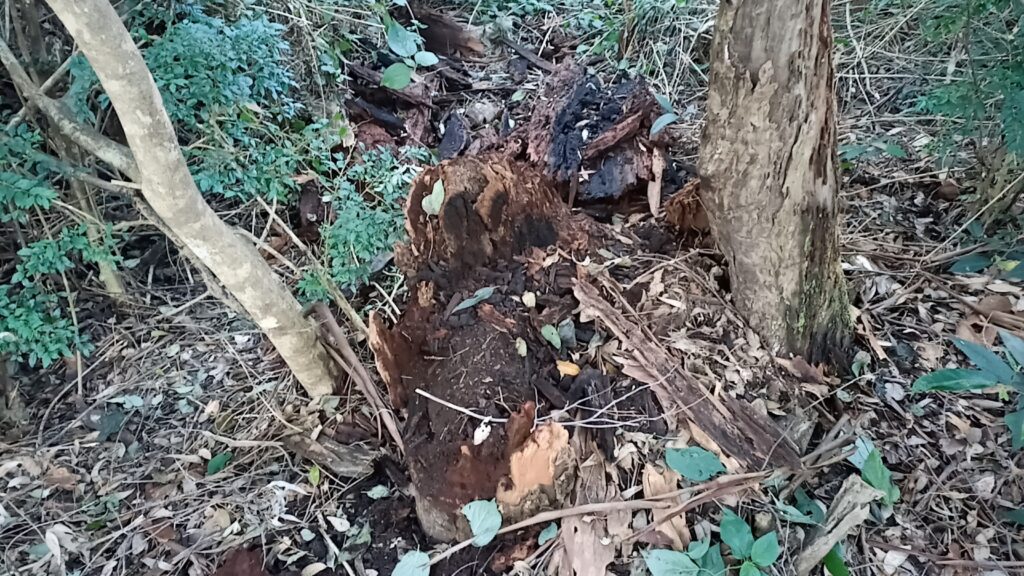

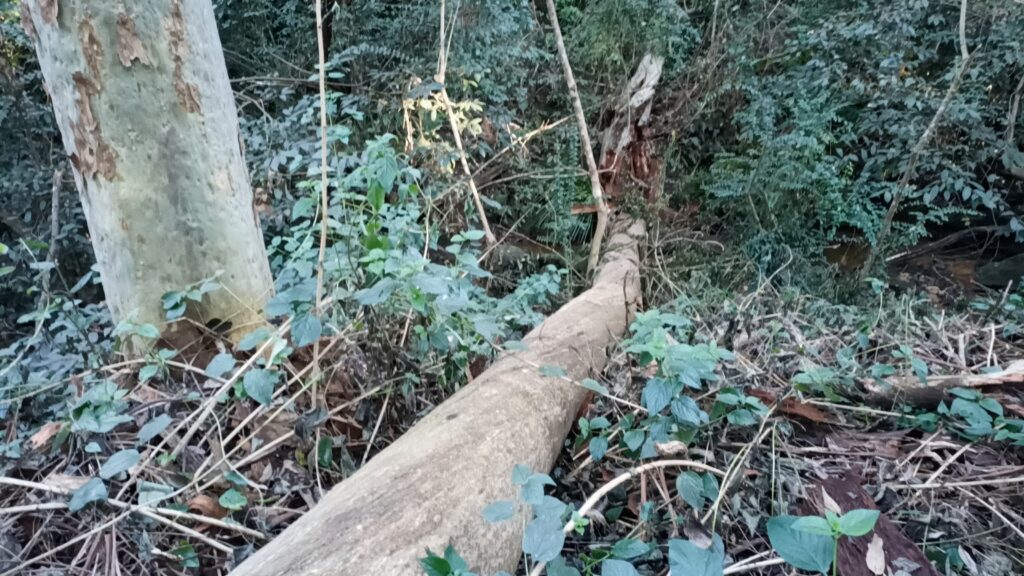
Rather than let the lantana close in on the vacated space, I thought I would open up the area for the nearby sandpaper fig trees which are sure to appreciate the extra light.


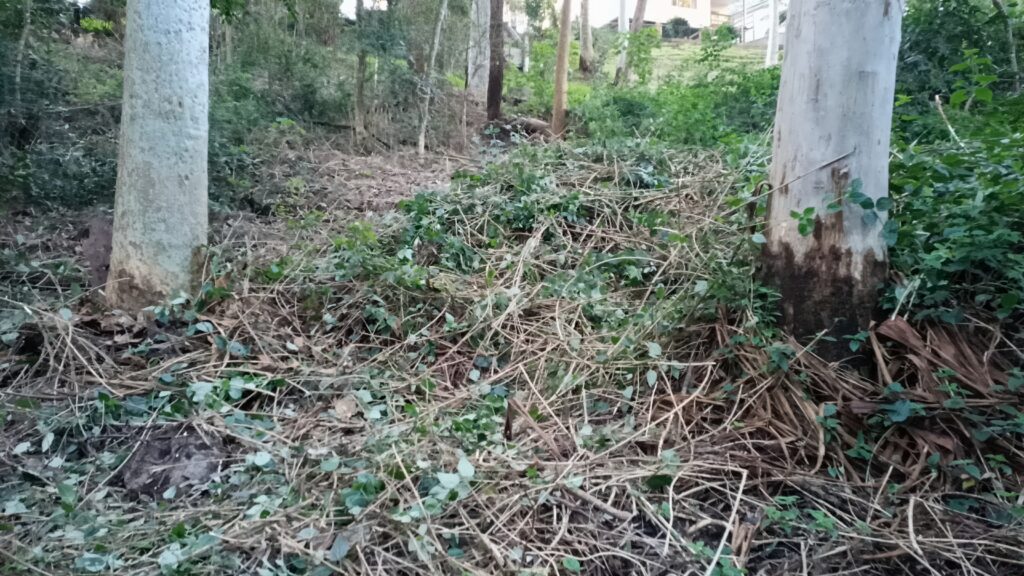
I have a long list of areas that need attention so I will need to get to work a bit earlier next week. That privet beckons me…
Working Bee – 10.03.2021
It was a productive day. After working on a small amount of palm grass before first fall, I decided to finally help out the gardia growing between the first and second falls. Gardia has been growing well but it is still having to compete with a lot of fishbone fern and some ginger lilly.
Here it is before trying to thin out the fishbone fern…
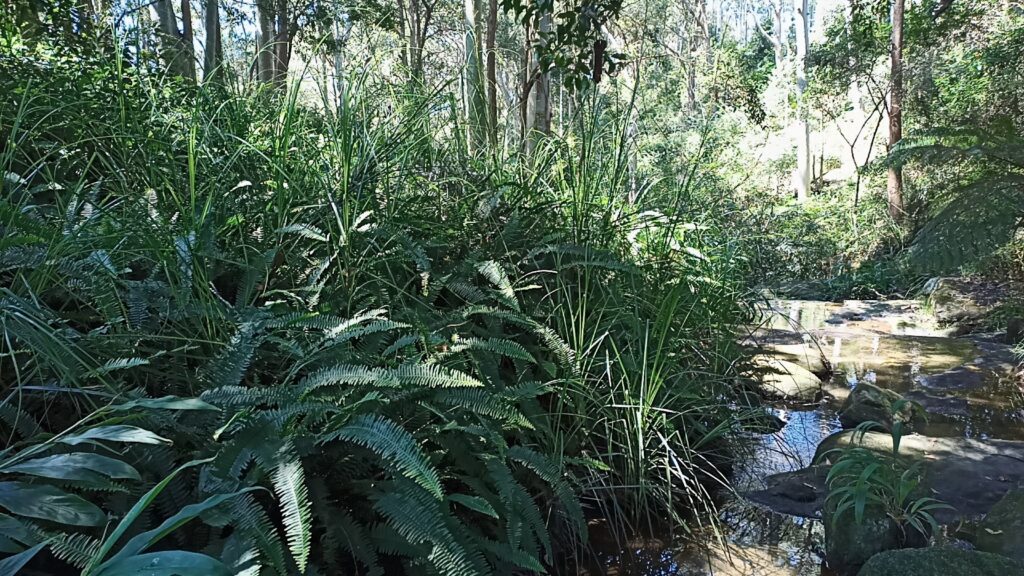 You can see in the image that the gardia (the tall grass seen in the center of the image), is getting above the fishbone fern but it is not very numerous. As I started weeding the fishbone fern I found a lot more gardia that was just too small to get to the light and hence were not looking very healthy.
You can see in the image that the gardia (the tall grass seen in the center of the image), is getting above the fishbone fern but it is not very numerous. As I started weeding the fishbone fern I found a lot more gardia that was just too small to get to the light and hence were not looking very healthy.
After spending half an hour or so removing fishbone fern, the gardia now has a lot more space to expand and young shoots should now be able to grow above the fern. The image below shows the spot after weeding. I tried to use some judgement as to how much I should remove. I would not want to allow erosion to take place. Fast flowing water can cover the area if there is heavy rain.
 A hairy clarodendrum I walk past when going to site A is being attached by these guys…
A hairy clarodendrum I walk past when going to site A is being attached by these guys…
It was a straight forward lantana and privet removal after this point. No photos to show because I was too tired afterwards. I starting an area requiring maintenance but then expanded on that to clear a good section under ‘Site A’.
One concern is a lot of plants showing a brown discolouration. I am hoping it has to do with the extra light coming through after a large gum was removed in a nearby residence but that does not seem to match. I noticed it on some bleeding hearts and most notably, on the giant tree fern along the creek after second falls. Hopefully it is not a big deal but it is a concern at present. Might need to ask the experts at lakemac landcare.
Working Bee – 27.02.2021
Dick’s Creek had a visit from the green team from the lake macquarie landcare resource center during the week. Many hands make light work and that was definitely the case on the day. Some good progress was made on the day despite delays due to rain. While there on the day I noticed some sections done previously had sprung back. Namely lantana and privet as usual. I have been quite taken back by the speed that everything is growing at present. Rain is great for all the plants, weeds included unfortunately.
Yesterday, I had a chance to get some guards around the Cheese saplings I planted a month or so ago.
Everything is looking super green at present. Maiden hair along the cliff face next to the first falls has never been so abundant.
[metagallery id=394]
Palm grass is looking a bit too healthy at various places along the creek. At placed, I need to consider erosion control. When the water flows fast, it takes anything that is loose down stream so sometimes it is just better to leave some weeds in place for this reason. Here is what I am describing…
Further along, I am pushing back the swedish Ivy as various ferns show up. Hopefully it is a case of slowly does it. Things are looking much better but it can all go backwards quickly if I don’t keep an eye on it.
A trail that I often used that leads from the second falls around to site A was enveloped by fishbone fern. Impressive. Annoying but still impressive. I cleared the trail. This video shows the area and also one of the areas done by the green team.
Also done by the the green team and I last Tuesday…
Continuing on from that section I cleared lantana and privet back down the creeks edge (which still needs some serious privet treatment).
Here is the summary of the day which I try to do for each working bee. It was a good day…
Working Bee – 27.07.2019
We have a tentative landcare working bee scheduled for the 27th of this month at 9.00am. Come along if you can…

